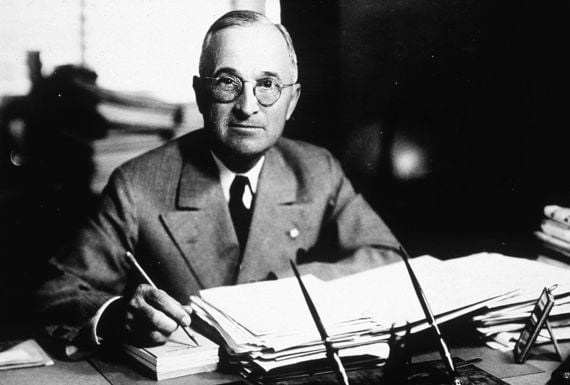As the US presidential election edges ever closer, aspiring candidates are sure to ramp up their political communications campaigns in a bid to win a ticket to the White House.
There is nothing that influences public opinion like a coherent campaign communicated in a succinct and easy-to-understand manner.
All told, a successful campaign can be the difference between a theoretically good candidate fading into obscurity and a bad candidate on paper writing their way into immortality.
There has been a wide range of political campaigns in presidential elections in the post-war era and each has affected the voting public in different ways.
From TV debates to Twitter, political communications have moved with the times and each emerging technology has brought with it a new form of political campaigning.
In this year's debate, the successful Democratic nominee will have to fight a tireless campaign on social media if they are to defeat Donald Trump and take residency in the White House.
However, they will also have to use lessons from these post-war campaigns
Harry Truman's Whistlestop tour - 1948 presidential election

President Harry S. Truman.
It didn't look good for Harry Truman in 1948.
The then-current US President had previously served as Franklin D. Roosevelt's Vice President and assumed the role of president when Roosevelt died in 1945.
One of the most universally liked presidents in modern American history, Roosevelt left big shoes to fill and Truman simply couldn't win the public over like his predecessor did.
With civil rights tensions mounting and an increasing hysteria and paranoia around communism, Truman faced a difficult campaign to persuade the average American that he was the man to deal with the job.
Many in the Democratic party even favored nominating someone else for the 1948 election and it seemed a formality that Republican Thomas Dewey would ease to victory.
Such was the media faith in Dewey that the Chicago Daily Tribune erroneously (and infamously) printed "Dewey Defeats Truman" on its front page the day after the election.

Truman gleefully held the incorrect headline aloft
To combat this, Truman undertook one of the most exhaustive campaigns in recent memory to cause a stunning upset.
With television still in his infancy, he couldn't use the new technology to influence the masses and so embarked on an altogether more old-fashioned campaign.
With everyone from national newspapers to officials within the Democrat party telling him he had no chance of success, Truman went on a 21,000-mile 'whistlestop' tour where he gave over 350 speeches across the country.
He traveled by train from town to town delivering his message to the American electorate from the back of his rail car.
The speeches drew huge crowds and as many as one million people gathered to see him in New York City.
Truman's campaign was extremely effective and he won a stunning come-from-behind victory against Dewey, a feat that was even more remarkable given that he polled at just 36% in early 1948.
Read more: A tale of two winter White Houses, Truman's and Trump's
JFK and the first television campaign - 1960
While Truman actually delivered the first televised presidential address in 1947, it was John F. Kennedy who made the medium his own 13 years later.
Kennedy famously took part in the first-ever presidential debates to be broadcast on live television and it helped to completely swing public opinion in his favor.
Richard Nixon, his much older opponent, Kennedy was considered to be the underdog given Nixon's experience as a Vice President.
However, Kennedy's youth would work in his favor. He embraced television and all that came with it and he agreed to wear television make-up, something that Nixon reportedly eschewed because of its feminine ties.

Kennedy and Nixon prior to their first debate in Chicago in 1960 - Wikimedia
As a result, Nixon looked pale and appeared to boast a five o'clock shadow during the debate.
Kennedy, on the other hand, looked handsome and energetic, a paragon of youthful exuberance.
In terms of performance in the debate, there was little to separate the two candidates. Listeners on the radio actually thought that Nixon had edged it.
Yet, viewers believed that Kennedy had landed a resounding victory and he swept to the oval office in the November election, proving that a political campaign was as much about appearance as it was about content.
Read more: Bon Jovi’s "2020" album cover inspired by John F. Kennedy
Donald Trump and the Twitter campaign - 2016
Twitter may have existed during the 2012 presidential election when Barack Obama won reelection to the White House, but Donald Trump really made the medium his own four years ago.
The current US President has sent just shy of 50,000 tweets from his official account @realdonaldtrump.
He used it with great effect during the 2016 election to whip his supporters into a frenzy about media bias, to denigrate his opponent Hillary Clinton with slander and to parrot conspiracy theories about a "rigged" election system.
Phrases like "drain the swamp" and "Crooked Hillary" became synonymous with Trump's Twitter account and his tweets regularly wound up on the front pages or being discussed on news shows.
Wow, just came out on secret tape that Crooked Hillary wants to take in as many Syrians as possible. We cannot let this happen - ISIS!
— Donald J. Trump (@realDonaldTrump) October 24, 2016
Trump was a media mainstay throughout 2016. His controversial statements simply generated thousands of clicks to each story and, in turn, Trump got billions of dollars worth of free campaign advertising.
Leslie Moonves, the CEO of CBS, summed up the relationship in 2016.
"It may not be good for America, but it's damn good for CBS."
Trump's name was ubiquitous in the media thanks to his Twitter activity and it kept him in the minds of the voting public.
After decades of lies and scandal, Crooked Hillary's corruption is closing in. #DrainTheSwamp! pic.twitter.com/YivCacmkKq
— Donald J. Trump (@realDonaldTrump) November 2, 2016
Bernard Cohen, a former Democratic delegate in Virginia, famously said in 1963 that the press "may not be successful much of the time in telling people what to think, but it is stunningly successful in telling its readers what to think about."
His words may have never been more pertinent.
Because, while Trump may have repulsed certain voters, his message appealed to countless others and the media gave him a free platform to communicate that message to the undecided masses.
Read more: Trump officially launches 2020 Irish American Heritage Month




Comments